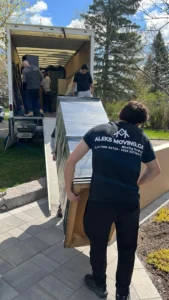Moving can be a stressful experience, but with the proper preparations and techniques, you can make the process smoother and less daunting. One crucial aspect of moving is properly taping your boxes to ensure your belongings arrive at your new home safely and sound. This comprehensive guide will walk you through the step-by-step process of how to tape boxes for moving. Whether you’re a seasoned mover or a first-timer, this guide will provide valuable insights to make your move successful.
Gather Your Materials
Before you tape boxes, gathering all the necessary materials is essential. Having everything you need within reach will help you work efficiently and avoid unnecessary interruptions.
- Packing tape: Invest in high-quality packing tape, shipping tape, thinner tapes, thicker tapes, box tape, and duct tape in various sizes to accommodate different box sizes and weights.
- Scissors or tape dispenser: Ensure you have a reliable tape-cutting tool, handheld tape dispenser, tape gun.
- Quality moving boxes: Choose sturdy, corrugated boxes, packing boxes, and cardboard boxes that can withstand the rigors of transportation.
- Optional: Bubble wrap, packing paper, acrylic adhesive, extra strips, and labels: These additional materials can help protect fragile items and keep your boxes organized.
Preparation
Before you begin taping boxes, take some time to prepare your workspace and organize your items.
Clear and Clean
Start by preparing the workspace where you will be packing your boxes. Clear any clutter, debris, or obstacles that may hinder your progress. A clean workspace will make the process more efficient and less stressful.
Additionally, ensure that the boxes you plan to use are clean and free of dirt or dust. Cleaning your boxes in advance will help keep your belongings clean during the move.
Organize Your Items
To make the packing process more manageable, sort and categorize your belongings. This will help you determine the appropriate box sizes and packing materials for each group of items. Pay special attention to fragile items requiring extra care and protection during the move.
Taping Techniques
Now that you’re prepared, you must learn the proper taping techniques to secure your boxes effectively.
The H-Method
The H-method is a commonly used taping technique that provides sturdy support for your boxes. Follow these steps to tape your boxes using the H-method:
Seal the bottom of the box: Place a strip of packing tape along the center seam of the bottom of the box.
Create an “H” shape: Apply two more strips of tape perpendicular to the first strip, forming an “H” shape. Ensure the tape extends a few inches beyond the edges of the box.
Reinforce the corners: Use additional tape strips to reinforce the box’s corners, ensuring extra durability.
The H-method provides excellent support, especially for heavier items.
The X-Method
The X-method is an alternative taping technique that also provides robust box support. Here’s how to tape your boxes using the X-method:
Seal the bottom of the box: As with the H-method, start by sealing the center seam of the bottom of the box with a strip of packing tape.
Create an “X” shape: Apply two strips of tape diagonally across the bottom of the box, forming an “X.” Again, ensure that the tape extends beyond the edges.
Reinforce the corners: Like the H-method, use additional tape to reinforce the box’s corners.
The X-method distributes weight evenly and is particularly useful for boxes containing fragile items.
Reinforcing Seams
Regardless of the taping method you choose, it’s essential to reinforce the seams and corners of your boxes. This added step ensures the tape remains secure during transportation and minimizes the possibility of packages splitting open.
Securing Special Items
Certain items require extra attention and care when packing. Here’s how to secure fragile and heavy objects properly.
Fragile Items
- Wrapping delicate items carefully: Use bubble wrap, packing paper, or foam padding to protect fragile objects. Wrap each item individually and secure the wrapping with tape.
- Labeling fragile boxes: Clearly label boxes containing fragile items with a “Fragile” warning. This will alert movers to handle these boxes with extra caution. If you’re looking for reliable Oakville movers, just give Aleks Moving a call now!
Heavy Items
- Distributing weight evenly: Avoid overloading boxes with heavy items. Distribute heavy items evenly among multiple boxes to prevent them from becoming too heavy to lift safely.
- Using reinforced tape for heavy boxes: Consider wider and stronger packing tape for added security when packing boxes with heavy items.
Labeling and Organizing
Proper labeling and organization are key to a smooth move and a more straightforward unpacking process.
Importance of Labeling
Labeling your boxes is crucial for several reasons:
- Avoiding confusion on a moving day: Labeled boxes make it easier for movers to place them in the correct rooms.
- Creating an organized unpacking process: Labeling helps you prioritize which boxes to unpack first and locate specific items quickly.
Color-Coding
Take your labeling system further by using color-coded labels for different rooms. Assign a unique color to each room in your new home and stick matching labels on the corresponding boxes. This simple system will streamline the unloading process and save time and effort.
Packing Tips
Adequate packing is about taping boxes, efficient strategies, and careful planning.
Packing Strategies
- Start early and pace yourself: Begin packing well before your move date to avoid last-minute stress. Pack a few boxes each day to make the process more manageable.
- Fill boxes to the top: Utilize all available space in each box to minimize the number of boxes you need. However, avoid overloading them to the point of being too heavy.
Keeping an Inventory
Maintain a checklist or inventory of the items you pack in each box. Number the boxes and create a corresponding list to track your belongings. This will help ensure that nothing gets left behind during the move. Consider reading our article about how many boxes do you need for moving on our blog page now!
Common Mistakes to Avoid
Knowing what not to do is just as important as knowing what to do when taping boxes for moving.
Overloading Boxes
Overloading boxes with too many items can lead to several issues:
- Increased risk of packages breaking open during transit.
- Difficulty in lifting and moving heavy boxes.
- Potential damage to the items inside due to excessive pressure.
To avoid these problems, distribute the weight evenly among your boxes and use appropriate box sizes for different items.
Don’t cut corners by using low-quality packing tape. Investing in high-quality tape is essential for the security of your belongings. Low-quality tape may not adhere well, leading to box failures and potential damage to your items.
Neglecting Fragile Items
Fragile items require extra care and attention. Avoid common mistakes like insufficient wrapping, inadequate padding, or improper labeling. Protect your delicate belongings to ensure they arrive at your new home intact.
Final Preparations
Before the moving day arrives, make sure you’ve completed these final preparations:
- Double-check all your boxes to ensure they are securely taped and properly labeled.
- Create a loading plan for the moving truck to maximize space and minimize the risk of damage during transportation.
Conclusion
In conclusion, taping boxes for moving is a crucial step in ensuring the safety of your belongings during the transition to your new home. By following the techniques and tips outlined in this comprehensive guide, you’ll be well-prepared for a successful move. Remember to gather your materials, prepare your items, and use taping techniques to secure your boxes effectively. Proper labeling, organization, and packing strategies will further streamline the process while avoiding common mistakes and will help safeguard your belongings. With these insights and preparations, you can make your moving experience as stress-free and efficient as possible.
Professional Box Taping
When securing your precious possessions, trust the professionals at Aleks Moving. Our team is highly skilled in the art of box taping for moving. We use the best materials and techniques to ensure your items arrive at your new home in perfect condition. Make the smart choice for your move and choose Aleks Moving for expert box-taping services. Contact us now to schedule your move and enjoy peace of mind.
FAQs: How to Tape Boxes for Moving?
What type of tape should I use for packing boxes?
It’s recommended to use high-quality packing tape. Clear or brown acrylic packaging tape is commonly used. Ensure it’s at least 2 inches wide to provide a secure seal.
How should I prepare the boxes before taping them?
Before taping, ensure your boxes are assembled correctly, with all flaps folded and interlocking properly. Also, make sure your items are packed securely inside to prevent shifting.
What’s the best method for taping boxes closed?
The most effective method is to start by taping the bottom seam of the box with a single strip of tape, then add two additional strips perpendicular to the first, creating an “H” shape. Finally, reinforce the corners and edges with extra tape for added strength.
How do I prevent the tape from sticking or getting tangled while taping boxes?
Use a tape dispenser with a built-in cutter to prevent tape from sticking to itself. If you don’t have a dispenser, create a small tape “tail” by folding a corner of the video over itself, making it easier to grab when needed.
Should I label the boxes before or after taping them?
It’s generally best to label the boxes before taping them. Write the contents and destination room on the box with a permanent marker. This makes it easier to organize and unpack when you arrive at your new location.



